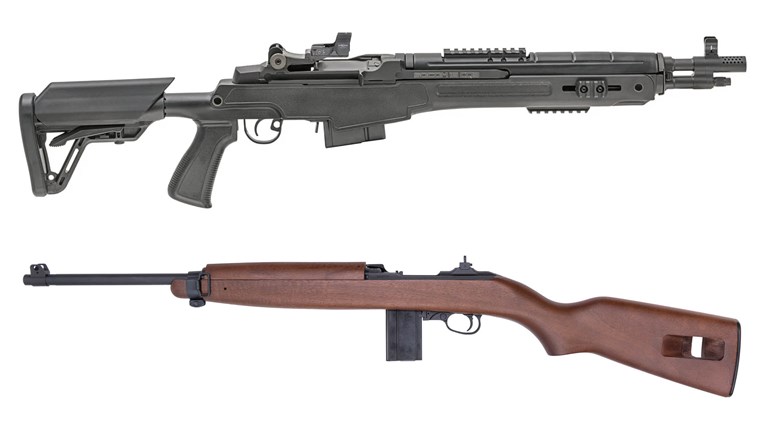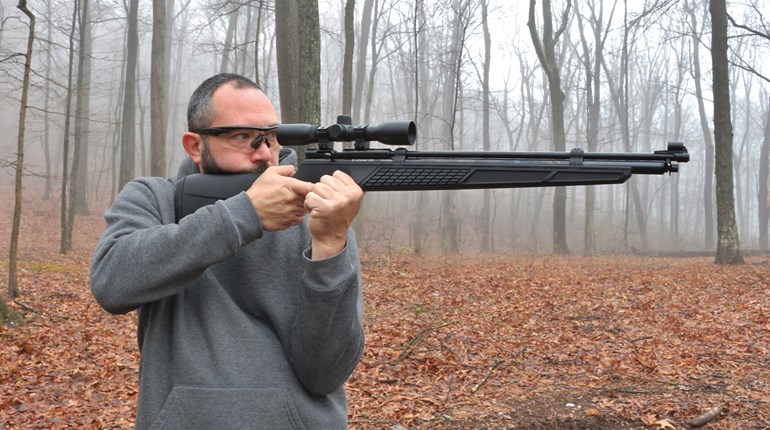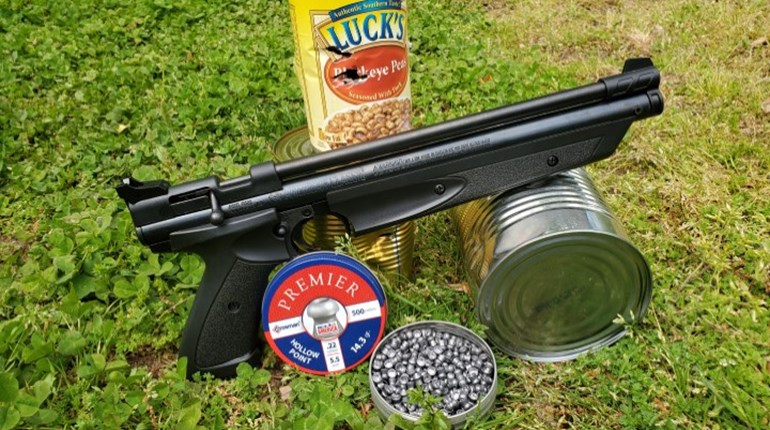
It looks like an AR-15; it feels like an AR-15; and it can serve as a cool way to introduce newcomers to the concept of a Modern Sporting Rifle without scaring them away with the noise, recoil and cost of ammunition. It’s the Crosman DPMS SBR Full Auto BB rifle.
I’ll admit I was a little bit skeptical. I mean, could a BB gun—even one that lets you fire on automatic—really be that much fun if you’re not a kid? The short answer is, yes! The long answer is a little more complicated, but still yes. So I’m glad I decided to give it a go.
Fair warning: don’t approach the concept with unrealistic expectations. It’s not really going to let you practice your trigger pull or work on long-range accuracy. But in terms of fine-tuning your shooting position or getting used to being in position for a while with the gun at the ready, this gives a taste of the real thing, thanks to the fact that the manufacturer stays as true as possible to the platform’s specs. These include a six-way adjustable butt stock, flip down sights, a charging handle and a bolt that locks back.

Getting started is easy. Crosman relies on dual CO2 cartridges to help you power through a magazine with the selector on automatic. That help with consistency of firing throughout the lifespan of the CO2 cartridges, and it’s a decision that pays off in that regard. While there are no specific figures publicized for effective range, you’ll get a nice grouping from start to finish as you run through the BBs on full auto at 15 yards because there’s no recoil.
As for distance itself, don’t think you’re that limited. The BBs will easily fly more than 100 yards—indeed, depending on your patience and environmental factors like wind, you can even hit a target at that distance shooting on semi-automatic. So, as with any gun, remember to abide by the safety rule about being sure of your target, especially when something might roam behind your target, or make sure there’s a backstop.
You install the CO2 cartridges in the magazine, which comes with an Allen wrench. All you have to do it oil the tip of the cartridges, use the wrench to back out the tension screws, insert the CO2, and tighten the screws back in so you puncture the tips of the compressed tubes. After a quick test—insert an empty magazine into the magazine well, adjust the selector switch to semi-automatic, and pull the trigger once; if you hear a click, you’re golden—you eject the magazine, load your BBs and get ready to have some fun.
When all is going well with the gun and all its accessories, you can expect to blow through several CO2 cartridge reloads in an outing, especially if you’re shooting on the automatic option. Figure on going through about 200 BBs between swapping out the CO2—a fairly simple task. If you’re planning to do much shooting at once, I’d suggest oiling the tips of your power cartridges before you head out as that will save a step during the shooting process. Another option is to buy extra magazines and set them up before you go, but more on that later.


The ability to switch from semi-automatic to automatic is based on how a real AR works. In a real AR, the hammer is in the trigger-group mechanism and the bolt carrier group cycles back into the buffer to reset the hammer. The DPMS SBR is slightly different because the hammer is in line with the buffer tube. The bolt assembly goes back into the buffer tube and sears the hammer up halfway in the buffer tube under spring tension, Crosman representative Jay Duncan explained. When the bolt cycles, it resets the hammer after each shot on semi-automatic, but it does not do that when the setting is on full auto until you release the trigger.
As for looks, the DPMS is a good clone of an AR. Besides having the heft of an AR (the weight is comparable even though the structural “metal” is a glass-filled nylon polymer), it boasts many of the features you’d expect in a real firearm, from flip-up “iron” sights to a six-way adjustable butt stock, to a Picatinny rail.
If you’ve read any blogs or FAQ sites about the product, you’re bound to have discovered a hint of dissatisfaction as minor shortcomings have been noticed. That said, Duncan gave assurances that these were just wrinkles associated with the rollout of a new product, and he said Crosman is ironing them out.
One complaint was that the magazine doesn’t last long—and with an MSRP of $49 for a replacement, it could be an expensive fix if you rectify the problem by just buying a new magazine. That said, the issue can be remedied more easily. Duncan said the woe was attributed to the seal for blowback function acting up or get pushed out of position pretty easily. Reseating the seal helps, and you can even replace it as needed.
The problem presented itself with the first production run and affected only a fraction of that shipment, Duncan said. “Some of the guns basically were missing and e-clip that would hold the green seal in place. It could cause it to flip while for firing, basically preventing the firing pin from striking the magazine,” he explained.
It’s worth noting that the speedloader presents minor difficulties, too. Basically, it has a holding well for BBs, and a spring-loaded plunger. An attachment hooks to the loading lever on the magazine and lets you push in new ammo pretty easily. While the concept is nice, it takes a certain touch to get it to work. Some critics address this on videos and say that jams are often related to using non-Crosman BBs, which can be ever so slightly bigger. I had to take the device apart to fix jams and I was using Crosman BBs, which was perplexing. But when it’s working well, it does make loading the magazine significantly easier.
Be sure to deplete your CO2 cartridges or take them out of the magazine when you’re not using the gun, as leaving them in could lead to functional problems.
As for extra magazines, you can buy them, but the company is selling them faster than it can make them. But, with the holidays coming up, Crosman has scheduled a production run that will hit inventory before Thanksgiving.


































